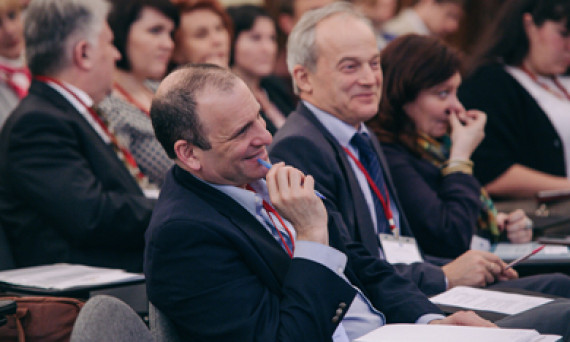On April 10th, the European University at St. Petersburg held a conference dedicated to the development of graduate-level education in Russia. The conference was organized jointly with the Vladimir Potanin Foundation and the Higher School of Economics in St. Petersburg.
In opening of the conference, Vice-Rector for GR Nikita Lomagin noted that the European University, which was founded 20 years ago, was originally conceived of as a “graduate school.” Even before Russia joined the Bologna Process, EUSP had already begun developing its Master’s programs. In following years, EUSP also founded three yearlong English language programs attended by students from North America, Europe, Australia, Southeast Asia and other regions. Education in these programs is not free of charge, and EUSP has enough resources to be able to compete in today’s international higher education market in Russia and beyond. Lomagin also thanked the Potanin Foundation for its active support of EUSP.
Conference attendees were also greeted by Alexander Semenov, Dean of the Department of History at the Higher School of Economics. He noted that the Higher School of Economics leads in Russia for the number of master’s degree programs offered and has accumulated extensive experience in developing such programs. The school’s double degree programs have been recently acknowledged a successful experience based on the results of the “5/100/2020” Program’s latest board meeting. Semenov joked that EUSP and the Higher School of Economics are two universities separated by a common mission.
According to Oksana Oracheva, who spoke on behalf of the Potanin Foundation, those gathered at EUSP were united not only in their passion for educational issues in Russia, but also because they have long been working with the Potanin Foundation. Focusing its activities on graduate programs, the Foundation has worked with EUSP since 2013. Oksana considered the conference as a dialogue on how to further develop Russian graduate studies, and noted that it was not by accident that the participants came from both state and private universities.
Artemy Magun and Alexander Semenov were the first presenters who spoke about adapting international graduate studies practices to the Russian educational system. Professor Magun pointed out that while progressive forms have been adopted in Russia, much has been done to preserve the previous system so as not to traumatize anyone. New forms are laid over old practices. Undergraduates should be prepared for graduate programs, creating a base of general education; otherwise the difference between Bachelor’s and Master’s programs rest unclear. Graduate studies were designed to include the opportunity for foreign study in order to ensure the interchangeability between Russian course and those taken abroad.
Next came a report by Vladimir Khalin (Department of Economics, SPbSU) on graduate studies and their history in Russia. “Most people want to analyze what we wanted, and what we got,” he said, noting that what we now call Master’s education was born in Russia in 1993. Based on the results of graduate programs over the past 23 years, we can conclude that changing standards and regulatory requirements every two to three years is “dangerous.” Excessive administrative oversight is unwarranted, and universities should be given the right to decide many issues on their own, allowing rectors and the university community to make authoritative decisions.
Vice Rector of the Higher School of Economics Sergei Roshchin delivered a report on interactions between educational programs and the labor market in Russia. In spite of the aforementioned 20-year history of Master’s programs in Russia, he believes that fundamental changes could only be expected in 2011 and again in 2015. Mass admission to undergraduate programs happened only in 2011, and in 2015 those students will graduate. If previously the majority of Russian students entered Specialist’s programs, a reasonable questions arises: what does a Master’s degree offer beyond a Specialist’s degree, making it so that the number of students in Specialist’s programs is currently decreasing? The very question of differences between Bachelor’s and Master’s programs has already been touched upon. In 2010, 160,000 students were enrolled in Bachelor’s programs. By 2011, their numbers had already grown to 850,000. Upon graduation they will massively enter the labor market and demand for Master’s programs will increase. Until recently, the share of workers with Master’s degrees was negligible, so discussing the role of the Master’s degree in the labor market simply did not occur. 2015-2018 will be a fundamentally different era, and we will see the true “output” of Master’s programs only in 2018.
Gevorg Avetikyan
































